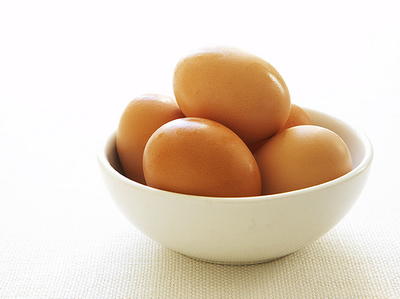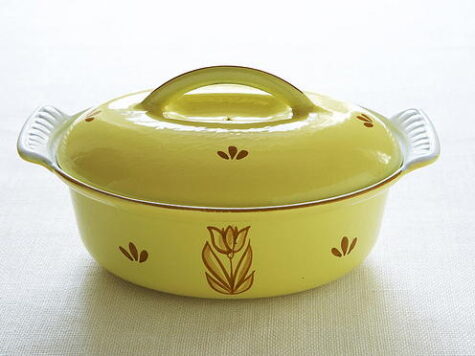
This image courtesy of Joseph DeLeo
One of the many triumphs of the French pastry kitchen, brioche is a beautifully sweet and buttery yeast bread. It is the perfect foundation for a superb bread pudding; the perfect breakfast toast; the perfect base, spread with anything from pate de foie gras to homemade raspberry preserves. And nothing, NOTHlNG, makes a better French toast! It’s impressive to serve, deeply satisfying to eat and not at all difficult to prepare. Brioche is not a fussy dough, but it does take a little time. Kneading the dough thoroughly and letting it rise overnight in the refrigerator ensures a moist loaf, full of flavour, with a fine, delicate and tender crumb. As with so many other yeast breads, brioche can adapt to suit your schedule; you can prepare the dough one day, and bake it the next. Be sure to use a good-quality butter for this recipe: a poor-grade brand with a high moisture content will throw off the balance and flavour of the bread. Both the butter and the eggs should be as fresh as possible. Although brioche can be made completely by hand, I find a heavy-duty stand mixer makes the initial mixing of the ingredients and incorporation of the butter efficient and easy. I have given quantities below to make two large loaves, or two traditional fluted brioche a tetes, but the risen dough can beformed into an almost infinite number of traditional and non-traditional shapes, from tiny brioche a tetes to the filled brioche doughnuts. Best of all, baked brioche freezes beautifully!
Serves2 9×5-inch loaves or 2 8-inch brioche a tetes
Recipe CourseSide Dish, Snack
Dietary ConsiderationHalal, Kosher, Peanut Free, Soy Free, Tree Nut Free, Vegetarian
MealBreakfast, Brunch, Snack, Tea
MoodAdventurous, Stressed
Taste and TextureButtery, Rich, Sweet
Type of DishBread, Yeast Bread
Ingredients
- 2 packages (about 5 teaspoons) active dry yeast
- 1 cup warm (105° to 115°F) whole milk (3.5%)
- 1½ teaspoons granulated sugar, to activate yeast
- 5½ cups all purpose flour
- 2 teaspoons salt, preferably sea salt or kosher salt
- 6 tablespoons granulated sugar
- 6 large eggs, at room temperature
- 1½ cups fresh unsalted butter, never frozen, at room temperature but not overly soft
- 1 egg lightly beaten with 1 tablespoon milk, for glaze
- Additional unsalted butter, at room temperature, for greasing the pans
Instructions
-
In the bowl of a stand mixer, or a large mixing bowl if preparing the dough by hand, sprinkle the yeast over the warm milk. Stir in the 1½ teaspoons of sugar and let the yeast proof for 5 to 7 minutes, until foamy and bubbling. Add 1 cup flour and the salt, beating with the paddle attachment or a wooden spoon to make a soft, smooth batter, about 5 minutes.
-
Beat in the remaining 4½ cups flour and the 6 tablespoons sugar in three additions, beating in 2 eggs after each addition of flour. Mix well between additions, making sure you scrape down the sides and bottom of the bowl. Beat until a smooth, soft and elastic dough is formed, about 10 minutes with the dough hook attachment, or 20 to 25 minutes by hand. I actually like to turn the dough out of the mixer at this point and hand-knead. The technique is simple (and great for relieving stress—cheaper than a therapist!). Slap the dough onto the counter, then with the heel of one hand push it through the middle into the counter. With the other hand, fold the far side of the blob towards you, over onto itself, and rotate the dough about 90 degrees. Repeat this pushing, folding and rotating cycle several times, then give the dough another good hard slap onto the counter. (Don’t add any extra flour at this point, even if the dough feels sticky; just use a dough scraper to gather the dough off the work surface. As the dough becomes more elastic, it will lose its gumminess and become smooth.) Do a stretch test: pinch some of the dough and pull it upwards. When the dough is ready, it should feel springy and elastic.
-
If you have removed your dough from the stand mixer, return it to a clean mixer bowl. If you are preparing the dough entirely by hand, you may find the next step easier in a large mixing bowl with a wooden spoon. Knead or beat the butter into the dough in small portions, fully incorporating each addition before adding the next. This process is definitely easier with a dough hook, but it is not impossible by hand. Squeeze the first few additions of butter through the dough, kneading until it is absorbed, then use a wooden spoon to beat in the remaining additions to prevent the dough from getting greasy and slippery, a sign that the butter is melting and not getting properly incorporated. The butter should be malleable, but not overly soft, and the dough should not get too warm during this process.
-
When the last of the butter has been beaten in, continue beating the dough until it is very smooth, glossy and elastic, about 5 minutes with the dough hook, or 10 minutes by hand. The dough should now have reached the “clean-up stage”—it should come away from the sides of the bowl in a smooth entity, or should neatly roll on the counter, no longer sticky or tacky. Transfer the dough to a large, lightly buttered bowl and cover the bowl with a sheet of plastic wrap. Leave to rise at warm room temperature, away from any draughts (about 75 degrees is perfect), until doubled in bulk, about 1¼ to 2 hours.
-
Punch the dough down and flip it over, deflating it completely. The buttery side should now be facing up. Cover again with plastic wrap and refrigerate for 2 to 3 hours. Punch the dough down, flip it once more, cover the bowl with plastic and weigh it down with a plate or dish, making sure the dough won’t be able to creep around the sides of the weight and escape the confines of its bowl. (I have seen renegade doughs running rampant over the bottles and jars on refrigerator shelves more than once, and it’s not a mess that you will forget having to clean up! Not to mention the waste of time, energy and perfectly good butter.) Return the bowl to the coldest part of your refrigerator and leave there overnight. If the dough is left longer than 8 hours, check periodically to make sure it has not risen above the bowl; gently punch it down as necessary. The brioche dough may be frozen at this point, wrapped very securely. Allow the dough to thaw in the refrigerator for 4 to 7 hours, then proceed with the shaping, final rising and baking.
-
Several hours before you plan to bake the brioche, remove the dough from the refrigerator, punch it down and turn it out onto a very lightly floured surface. Invert the bowl over the dough and let the dough rest for 10 minutes. (At this point, the dough can be shaped for other pastries as well.) Meanwhile, butter two 9 × 5-inch metal loaf pans, or two 8-inch fluted brioche moulds (or one of each!) and set aside.
-
To form two 9 × 5-inch loaves: divide the dough into 6 roughly equal parts and cover 5 of these with plastic wrap to prevent them from drying out. Roll the remaining portion on the counter into a smooth ball, plumping it by caressing the sides of it with your hands from top to bottom, pulling the surface taut and smooth and tucking the excess dough underneath the ball. Set the ball in the end of one of the prepared loaf pans and cover it with plastic while you repeat the process with the remaining pieces of dough. Place 3 balls in each pan, In a row.
-
To form two 8-inch brioche a tetes: divide the dough into 2 equal portions. Cover 1 portion with plastic wrap while you work with the other. Divide this half into 8 relatively equal portions, then cover 7 of them with plastic. Roll the remaining portion on the counter into a smooth ball as for the 9 × 5-inch loaves above. Place this ball in the bottom of one of the prepared fluted moulds. Repeat the rolling process with 6 of the remaining pieces of dough, setting them around the outside of the mould over the first ball. Roll the last piece into a smooth ball and nestle this into the centre of the circle of balls. Cover the pan loosely with plastic wrap and repeat with the second half of the dough.
-
Cover the pans loosely with plastic and drape a dishtowel over top. Let the shaped loaves rise in a draught-free place until plumped and risen, but not quite doubled. This last rising can take between 1½ to 2½ hours, as the dough is still chilled from the refrigerator. Keep an eye on the dough and make sure that it does not rise too much, or you will not get as good an oven-spring (the big initial rising in the oven).
-
. During the last 20 minutes of the final rising, preheat the oven to between 375° and 400°. Brush the plump loaves with the egg-milk glaze and bake them for 35 to 40 minutes, or until they sound hollow when tipped out of their pans and tapped on the bottom. Be careful when handling the hot loaves, as the joints between the sections are still very soft and fragile. As the brioche cools, the loaves will become firm and less delicate.
-
. Turn the loaves out and cool completely on wire racks before serving or wrapping tightly in plastic wrap and aluminum foil and storing or freezing. The baked brioche can be frozen for up to 2 months, well-wrapped. Thaw at room temperature for about 4 hours.
2001 Regan Daley
YOUR RECENTLY VIEWED RECIPES
Free recipes, giveaways, exclusive partner offers, and more straight to your inbox!
Thank you for signing up!
We were unable to sign you up – please try again.
We are adding your Comments. ![]()
Thank you! Your comment has been added.
We are sorry. There was an error tyring to post your rating and review.
Your comment will appear after our editors have had a chance to review it.


